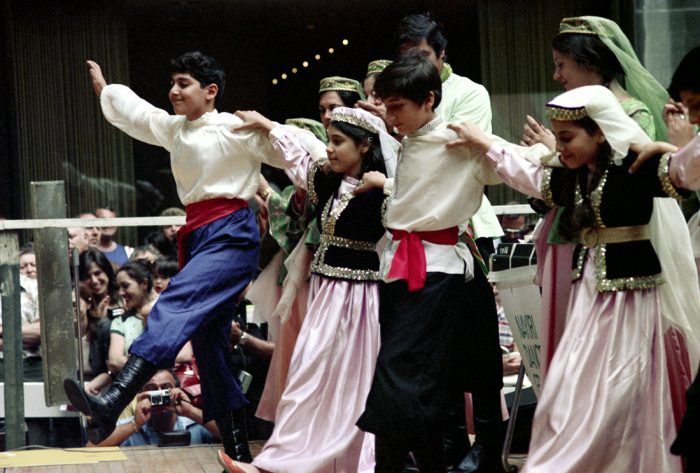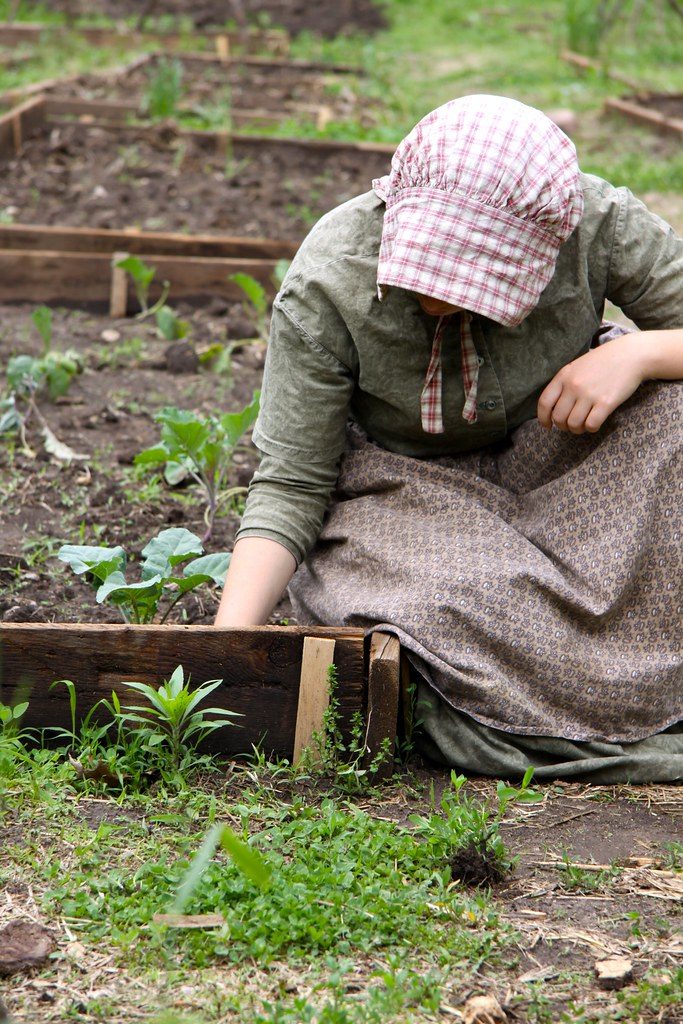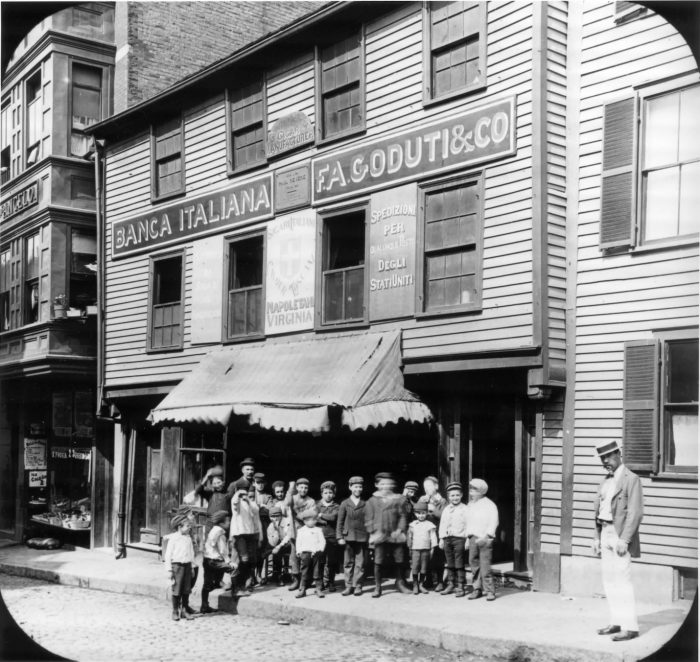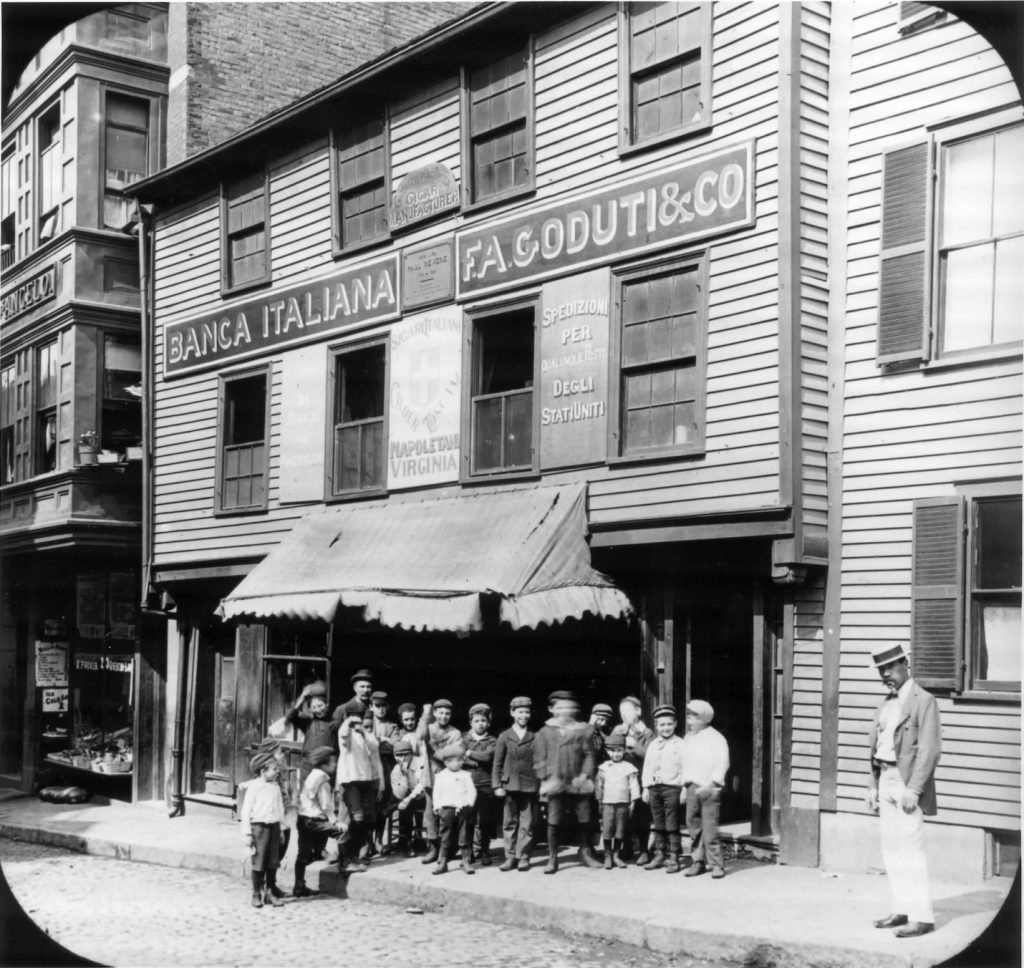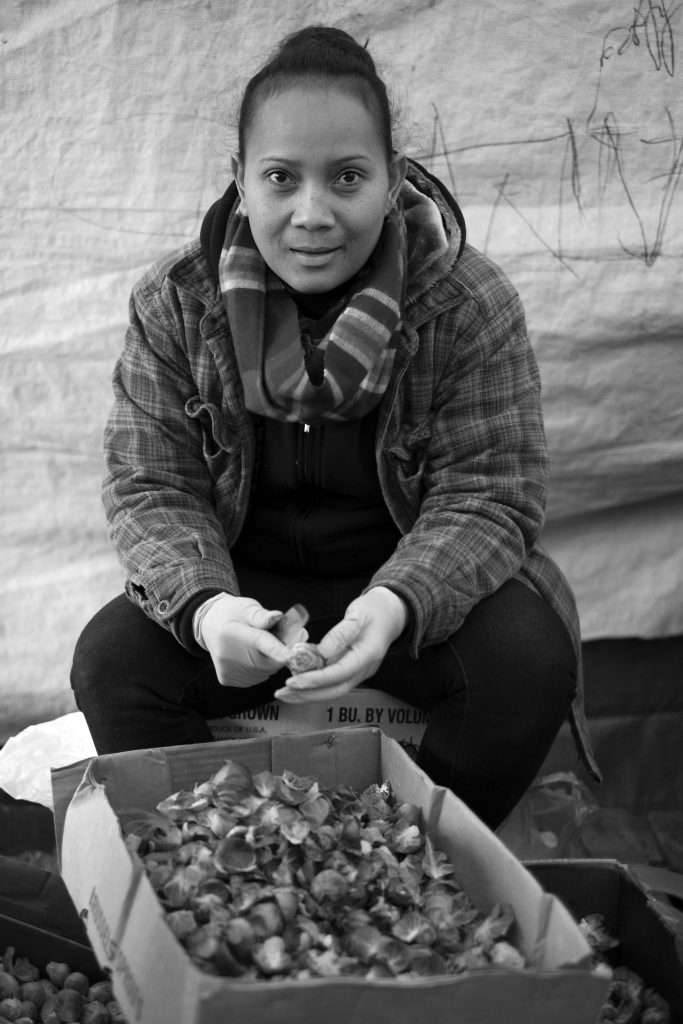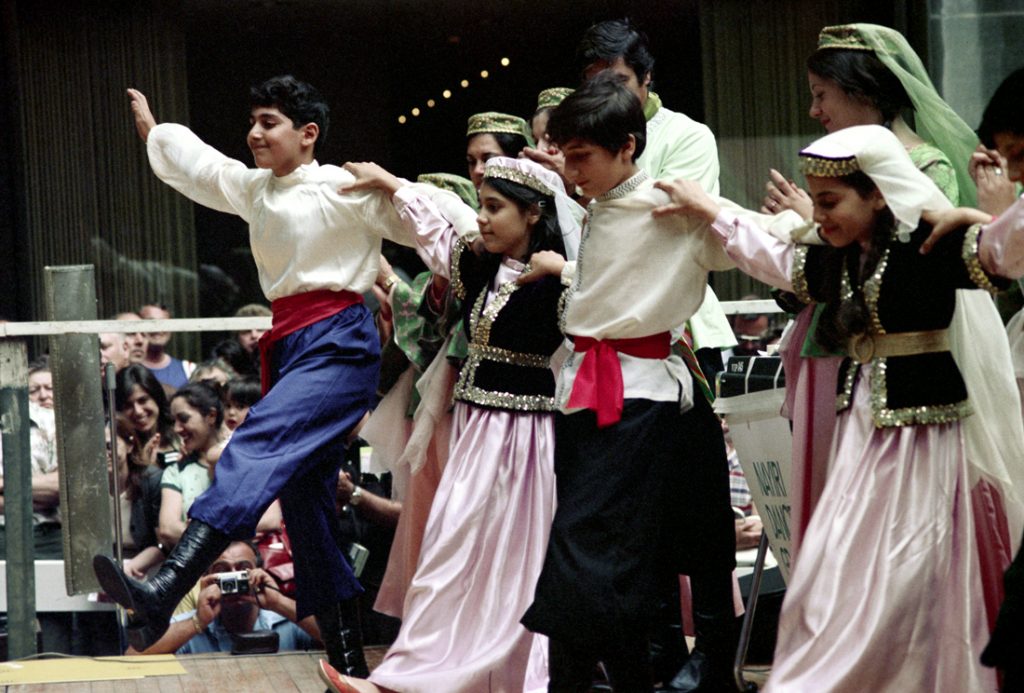
Throughout the “Bicentennial Era” (1971-1976), Americans commemorated the two-hundredth anniversary of the Declaration of Independence and American Revolution in different ways. In Ogden, Utah, the city restored its historic Union Station and opened a railroad museum inside. In Washington, D.C., two brothers formed the Afro-American Bicentennial Corporation and, with grant money from the National Park Service, researched and designated black history landmarks. Bowling Green State University moved a historic one-room schoolhouse onto campus. In Boston, members of the National Organization for Women marched in the parade commemorating the Boston Tea Party, connecting their own struggle for rights with that of the colonists. Boosters in Biloxi, Mississippi created a Seafood Heritage Trail. At the end of the period, the American Revolutionary Bicentennial Administration reported that over 90% of Americans participated in at least one Bicentennial-related activity.
The Bicentennial—as it was celebrated—was ultimately very inclusive: that is, many different groups and individuals found purpose in the commemoration and were able to observe it in ways that were impactful to them. But it certainly did not start this way. Originally, planners conceived of it as a top-down and centralized tribute to American achievement. Thinking critically about the Bicentennial is useful not only because of its place in the origin stories of many public history institutions and initiatives, but also because commemoration is often a key reason for, and part of, local history efforts of all kinds. Moreover, because of its unique juxtaposition of federal and local efforts, the Bicentennial continues to hold important lessons for contemporary planners of national commemorative events. For these reasons, it’s useful to track the way that the Bicentennial was envisioned, planned, and ultimately celebrated, both nationally and in local communities.
Contexts: “The New Nostalgia”
The Bicentennial occurred during an era in which Americans were much more interested in history than they had been in the forward-looking 1950s and ’60s. Many commentators remarked upon “the new nostalgia” that seemed to be permeating American culture—from fashion trends for platform shoes (originally seen as a 1930s throwback) to films such as American Graffiti and television shows like Little House on the Prairie, Happy Days, and The Waltons. While this cultural turn exceeded the Bicentennial, it helped stoke excitement about history. And, in many cases, as with CBS’s nightly Bicentennial Minutes and the landmark miniseries Roots (called by its author, Alex Haley, a “Bicentennial present to America”), which inspired so many, public and popular history efforts were inextricably connected, further evidence of how wide-reaching the Bicentennial was.
Planning for The Bicentennial
From the beginning, government leaders saw the upcoming Bicentennial celebration as a means to encourage patriotic feeling and behavior in Americans. By the mid-1960s, the consensus that had characterized the United States in the period following World War II was rapidly fracturing. Both federal and corporate interests saw the Bicentennial as an opportunity to unite Americans in their support for the larger political project celebrated by the commemoration.
Planning for the commemoration began in 1966, a full ten years before the actual event. President Lyndon B. Johnson created a bipartisan American Revolution Bicentennial Commission (ARBC) made up of a mix of elected officials, business leaders, and public figures. Under Johnson, the ARBC planned a World’s Fair, like the 1876 Centennial that had been held in Philadelphia. In the beginning, the ARBC conceived of the Bicentennial as forward-looking, an extension of Johnson’s Great Society programs; it was an opportunity to take stock and to bring new resources to as many Americans as possible. After the 1968 election of Richard Nixon, the ARBC changed tenor. Nixon made new appointments of political cronies and longtime supporters, and, rather than seize the opportunity to extend socio-economic benefits more broadly, the Nixonian Bicentennial was to be a celebration of American supremacy.
Critiques of Celebration
Throughout the 1970s, Americans questioned the meaning of the Bicentennial and Nixon’s plans for it. These critiques came from a variety of sources, including elected officials, commentators in the media, and activists. Despite the different origins, the concerns voiced by these individuals and groups were similar: Nixon was politicizing the Bicentennial planning by linking it too closely to his presidency and the 1972 campaign; the ARBC was corrupt and unwieldy; the Bicentennial effort was not representative; and—most significantly—an expensive, celebratory international exposition was out-of-step with the troubled contemporary moment.
Other challenges were even more pointed and reflected a critique of not only the shape of the celebration but also its cause. A group called the Bicentennial Without Colonies sought to use the commemoration to point to the disjunction between the ideals and realities of the Revolution, specifically the ongoing inequality, disenfranchisement, and imperialism evidenced by U.S. actions in Puerto Rico. Local and national organizers for the Black Panther Party and American Indian Movement were involved in this latter effort and in interviews, speeches, and publications, also drew attention to the federal Bicentennial’s erasure of both the histories of inequality and the contributions of people of color to the nation, while celebrating the histories and accomplishments of African Americans and Native Americans.
But suspicion of the ARBC and lack of enthusiasm for the World’s Fair model did not dampen excitement for the upcoming commemoration itself. All over the country Americans were finding their own ways to make the Bicentennial meaningful. A group called the People’s Bicentennial Commission emerged as the most sustained critics of the ARBC and Nixon, accusing the President of “stealing” the Bicentennial and seeking to use the commemoration for his own political purposes. Instead of following the “official” celebration, the PBC advised, Americans should find their own ways to celebrate, whether that meant researching local history, planning community events, or using the American Revolution as inspiration for contemporary social movements.
Grassroots History
Various groups, communities, and institutions found their own ways to commemorate the Bicentennial, many of which were historical in scope. AASLH’s Above Ground Archaeology taught people how to do local history. Historians Leticia Woods Brown and Ruth Edmonds Hill inaugurated the Black Women Oral History Project at the Radcliffe Institute for Advanced Study. Above all, the Bicentennial stoked new excitement in all kinds of histories: family histories, house histories, and community histories. The majority of grassroots Bicentennial projects were hyper-local; they spoke to the experiences and needs of their own immediate communities.
Although the majority of Bicentennial efforts were local in nature, there were a few projects—usually partnerships between federal, state, and commercial interests—that were national in scope. These included OpSail, a parade of sixteen tall ships that sailed into New York Harbor, the Bicentennial Wagon Train, a “history in reverse” yearlong journey by Conestoga wagons from western states to Valley Forge, Pennsylvania, and the Bicentennial Freedom Train, which displayed artifacts from the National Archives and elsewhere. Notably, even these national projects reflected the local character of the Bicentennial as they planned journeys across communities in the United States.
Likewise, many national institutions used the Bicentennial as an opportunity to plan special exhibits, events, and programs. At the Smithsonian, this included the Festival of American Folklife and the new National Air and Space Museum. The Metropolitan Museum of Art worked with Charles and Ray Eames to plan “The World of Franklin and Jefferson,” an exhibit that traveled to Paris, Warsaw, and beyond.
The Bicentennial Era also saw the creation of many new institutions including the African American Museum in Philadelphia and the Mid-America All-Indian Center in Kansas. Projects like these, which emerged from activist efforts at inclusive histories, were an important part of challenging and changing narrow and non-representative local and regional histories. From the beginning, Bicentennial efforts in states and communities exceeded those on the federal level.
Changing Course
By 1972, the critiques aimed at the ARBC and the Bicentennial effort had grown too loud to be ignored, and the Commission fell under investigation from the House Judiciary Committee and the General Accounting Office. ARBC also accepted that a large, centralized World’s Fair-type commemoration was unrealistic and changed gears. By early 1973, ARBC had settled on a project called “Bicentennial Communities” that would allow the national organization to support, publicize, and record more local Bicentennial programming and initiatives. The decision was a recognition of the community-based and grassroots efforts that were, by this point, characterizing commemorative planning across the nation. Bicentennial Communities would allow the federal body to preside over a decentralized commemoration that was different in shape and scope from any before it. At the end of the commemoration, more than twelve thousand Bicentennial Communities would be recognized by the federal body.
At the end of the Bicentennial, ARBA had disbursed over $20 million in administrative funding and grants-in-aid to each state, territory, and commonwealth—funding raised partly from the sale of commemorative coins, and partly from government appropriations. State legislatures added about $25 million towards projects and initiatives. Finally, the Department of Commerce used Title X funding to create jobs for over a hundred Bicentennial projects, including a transportation project in Vermont and a water and sewer improvement project on the Wind River Reservation in Wyoming.
Legacies of the Bicentennial
It is the availability of these resources that is ARBA’s—and perhaps the Bicentennial’s—greatest legacy. It is no coincidence, for example, that so many public history institutions and initiatives were founded in the mid-1970s; this is a result of both the excitement and the opportunities afforded by the commemoration. Projects inaugurated or expanded during the Bicentennial Era include the restoration of the historic utopian community site New Harmony, Indiana and the creation of Liberty State Park in New Jersey and Historic Fort Wayne in Detroit, among many others. For these projects, the commemoration was the impetus for more sustained efforts that extended in impact far beyond the scope of the Bicentennial Era.
By the end of 1976, official planners were congratulating themselves on a pluralistic, diverse celebration; however, the Bicentennial was inclusive because people made it so. Americans—informed and inspired by the black freedom struggle, women’s liberation, and other social movements—made the commemoration matter to their own communities and their own experiences. Ultimately, the way the Bicentennial was envisioned, planned, coordinated, and remembered by official agents was a response to this. In order to be successful, commemorative events and efforts must always be responsive to the needs of their audiences and constituents.
Lessons for Anniversary Commemorations
Several key points about the Bicentennial may be useful for those thinking about how to become involved in commemorations, such as the upcoming 250th anniversary (semiquincentennial) of the American Revolution:
The commemoration became an opportunity to question the relationship between the past and the present. Anniversaries are often an opportunity to take stock, and in the case of the Bicentennial, activists and historians started important conversations about not only the legacies of the American Revolution (most notably, who exactly benefitted from “independence”), but how the story was told—who was included and who was not. These conversations, in turn, informed many Bicentennial efforts.
Resources were used to develop and start initiatives, many of which are flourishing today. Federal and state funding helped kickstart projects, and public interest in history gave these projects their first audiences and supporters. Projects sought to involve as many people as possible in collecting, recording, researching, and interpreting history. Because so many projects were local in scope, they involved community members in oral history efforts and collection and archiving projects. Interactive, inclusive projects invited individuals to connect with the past and make their own meaning. Participating in grassroots local history efforts gave many people a chance to find and engage with histories that were relevant to them.
The culmination of ten years of planning at all levels of government, the final form of the Bicentennial—a pluralistic, grassroots celebration—was a symptom of larger shifts in how Americans used history to build and affirm individual and group identities. But more importantly, it was the result of concerted efforts by individuals and groups across the nation to make it meaningful: to question both the historical narrative and its official observation, to create projects and programs that reflected their own communities, and to take advantage of resources the commemoration made available. Although each commemoration is different—a result of its own social, cultural, and political contexts—it is worth looking to the Bicentennial for perspective on how subsequent commemorations might be successfully designed to maximize inclusivity and social impact.
Suggested Readings
American Revolutionary Bicentennial Administration. American Revolution Bicentennial: A Final Report to the People, (Vols. 1-6). United States Government Printing Office, 1977.
Burns, Andrea. From Storefront to Monument: Tracing the Public History of the Black Museum Movement. Amherst: University of Massachusetts Press, 2013.
Capozzola, Christopher. “It Makes You Want to Believe in the Country: Celebrating the Bicentennial in an Age of Limits.” In America in the Seventies, edited by Beth Bailey and David Farber. Lawrence: University of Kansas Press, 2004.
Cook, Robert J. Troubled Commemoration: The American Civil War Centennial, 1961-1965. Baton Rouge: Louisiana State University Press, 2007. See, especially, pages 29-49.
Gordon, Tammy S. The Spirit of 1976: Commerce, Community, and the Politics of Commemoration. Amherst: University of Massachusetts Press, 2013.
Jacobson, Matthew Frye. Roots Too: White Ethnic Revival in Post Civil Rights America. Cambridge: Harvard University Press, 2006
Lepore, Jill. The Whites of Their Eyes: The Tea Party’s Revolution and the Battle Over American History. Princeton: Princeton University Press, 2010
Rymsza-Pawlowska, M.J. History Comes Alive: Public History and Popular Culture in the 1970s. Chapel Hill: University of North Carolina Press, 2017.
Walker, William S. “Finding National Unity Through Cultural Diversity: The Smithsonian and the Bicentennial,” 153-95. In A Living Exhibition: The Smithsonian and the Transformation of the Universal Museum. Amherst: University of Massachusetts Press, 2013.
Zaretsky, Natasha. “The Spirit of ’76: The Bicentennial and Cold War Revivalism,” 143-82. In No Direction Home: The American Family and the Fear of National Decline, 1968-1980. Chapel Hill: University of North Carolina Press, 2007.
Author
~ M.J. Rymsza-Pawlowska is Assistant Professor of History and Co-Director of the Graduate Program in Public History at American University. She is the author of History Comes Alive: Public History and Popular Culture in the 1970s (2017), and is currently working on a new book about time capsules in the twentieth century. M.J. is also involved in a number of local history initiatives, including the D.C. Humanities Truck and the Washington History Conference. She can be reached at Rymsza at American dot edu.

